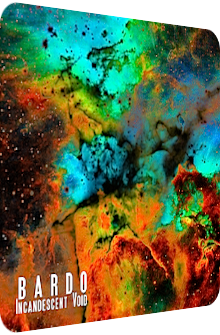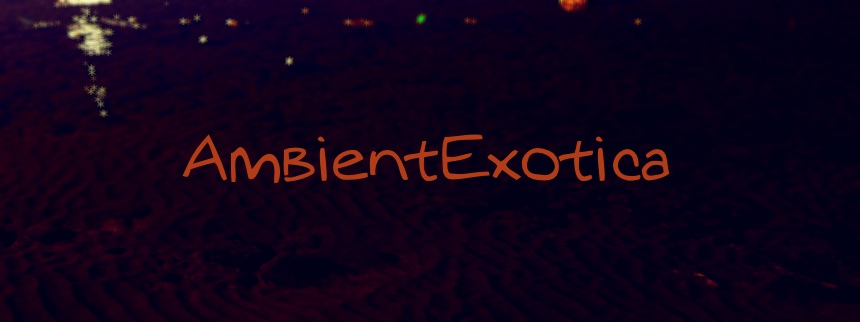
Incandescent Void
Bardo
2012
Incandescent Void is the Dark Ambient project of the Australia-based synth artist Kyle Pattrick. His dedication consists of creating wide spaces and universes filled with whirling spirits, cosmic phenomena and portentous planet-shattering drone layers. If you're following the Dark Ambient scene and are fond of aural space explorations, chances are high that you will fall in love with Pattrick's synthscapes he presents on his latest release Bardo, despite – or because of – their well-known structure and characteristic traits: they're gloomy, well-saturated with red and orange colors plus pitch-black emptiness, and accentuated by metallic clangs, with many truly original interwoven surprises that aren't usually linked to the Space Ambient genre per se. Hint: space opera is a fitting term, although for different reasons one might think of. And best of all: the album is given away for free at Darrell Burgan's Earth Mantra label. It's their 197th free release, and while I've listened to a lot of their material and am going to consider their back catalog in future reviews, Bardo by Incandescent Void is a truly magnificent, deeply frightening and ethereal hallmark with not too many glittering particles in the created galaxies. It's so incredibly cold out there.
Samsara (World-Form Of Suffering) isn't exactly the most rose-tinted, auspiciously titled point of departure I have ever encountered, but it prepares the listener for the grim voyage lying ahead of him or her. Dark machine drones are interspersed with brazen clangs and thin synth strings that waft through an atmosphere filled with super-deep bass pulses and square sine particles that becomes more arsenic later on when a quavering metallic haze is infused with brass-like waves whose sustain vanishes in the empty distance. Despite its gloomy setting, Samsara doesn't depict an utterly creepy situation. Every good space-oriented Dark Ambient album admixes several counteracting elements, and Kyle Pattrick is doing just that: each molecule is either clanging or consists of a pompously meandering and surprisingly soothing slime of dark matter with no perceptible melody. And that's the reason why this first piece fits well with the tradition of spacey Ambient albums, giving goosebumps, but doesn't cause anyone's blood to curdle. Up next is the 10+ minutes long Bardo Thodol, a galactic panopticon of horror strings and static noises going postal, creating the horrifying mood that Samsara purposefully neglected. Thunderous frizzles merge with fulminant faux-strings, insectoid staccato noises, the drone sounds of starship engines and earthquake-like rumblings. While Pattrick allows the reverb and sustain of each aural source to fade out, the ensuing period of decreasing sound layers is abruptly ended with a ginormous eruption, short bursts or hammering explosions. The second half is much quieter, with threatening piles of synth strings in the background and their pale-white piercing brethren in the foreground; I think of Györgi Ligeti's soundscapes, Tony Scott's one-off space album Voyage Into A Black Hole of 1988 or Gel-Sol's darker releases K8ema and Nequa (the latter co-written as Kids For Tomorrow with Nils Whitmont). The cacophony is bearable, but the sudden outbursts are tremendously scary. A huge composition!
Are you up for a literal incarnation of the term space opera? Abyssal Descent expresses this concept perfectly. Horrifying ecclesial organs fill the whole wide space, with distant airplane engines accentuating the probably clichéd, but nonetheless highly effective gruesomeness. The blood-red polyphony of the chords has the term doom all over it, and it is the full, vibrant sound of the organ as well as the permanent oscillation of downwards spiraling tone sequences and related course corrections into higher tone spheres that make this one hell of a tune. Dark Ambient fans will definitely drool all over this tune: it's über-creepy, it's sick, it's hell in space. Whereas Abyssal Descent glowed in highly saturated colors, the following Lingering is much thinner and icier. Emptiness and eternal wideness are as important parts as the organic gusts of Kaoss Pad synth strings, the Geiger counter-like clicks and the gelid iridescence of a distant star light. The fragility and the quieter panorama make Lingering a much-needed counterpart, it's almost balmy and entrancing, but never is it even distantly languorous or warm-hearted. The cacophonous parts are again a common theme, and although they're not as acidic and shattering, there lies an omnipresent scent of angst over every single note.
After all these synth maelstroms and scattered supernovae, it's time for a truly silkened Dark Ambient construction. Sonorous Passage is the most accessible and friendliest piece in relation to the other five tracks. It's a proper Drone track with belly-massaging bass breezes, glacial blizzards and blurry storms of white noise. Despite all these wind metaphors, the arrangement is nonetheless soporific, even tranquilizing. The upswell and downfall of the drones makes the wave-like trait of this composition apparent, and it is in the most quiescent passages that a cherubic glint becomes apparent. It's tiny, whimsically weak, and yet it's there, especially so in the second half where the iciness is exchanged with a solemn coldness. Sonorous Passage ends rather abruptly with a minimal fade-out time in order to make room for the final soundscape, the 12+ minutes long opus Return. Whatever positive connotation this word usually carries, it is indeed a fitting title, as the thinness of the previous track is inherited, but exchanged with golden beams of warm light. Two factors diminish the impact of the beams' effect: firstly, it's both the distance and the volume level, as they are floating in the far distance and are almost swallowed by the nothingness around them. Secondly, there are also murkier dissonances interwoven, damaging the luminescence and appeal of the stream. Return may also be a few minutes too long, as it doesn't offer any surprises or a variety of sound effects and protuberances, but since this is an Ambient album, the patience of the skilled listener shouldn't be lacking. It's a purposefully underwhelming, more gentle arrangement due to its function as the outro track and the forceful megalomania of the first couple of tracks.
Bardo is an acroamatic album due to its scope that's larger than one single life: galaxies and planets flow past the listener, metallic particles waft around the synth nucleus of each composition, and the occasional inclusion of a droning organ truly takes the cake. Depending on your knowledge of the genre, you may have heard all of these layers in other compositions and in various other concoctions, but that's only due to the cinematic nature of Pattrick's release. Fans of 2001: A Space Odyssey, Solaris and other serious contemplative sci-fi films as well as followers of the artists mentioned throughout the review will get more of the same dark interdependence of synth strings with brazen ornaments. The first three tracks are much more fulminant and threatening thanks to their ebullient clangs, jarring notes, scary synth strings and sudden outbursts, while the last three tracks are much calmer, more streamlined and accessible, although this doesn't tell a lot about them and may only cause the listener to see these as inferior. They're not. The focus on typical Drone aspects becomes more important, and while the settings are much thinner, icier and generally more entrancing, the dissonances are still apparent, the titular void of Incandescent Void still in place. It's a marvelous gem; Pattrick gives each composition enough room to breeze and to unveil its multiple layers. Dark Ambient fans and even fans of gloomier dystopias as occasionally depicted in tasteful New Age music, check it out for free at the Earth Mantra label page.
Ambient Review 132: Incandescent Void – Bardo (2012). Originally published on Oct. 10, 2012 at AmbientExotica.com.
